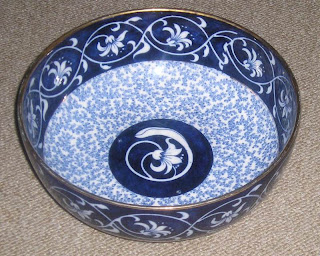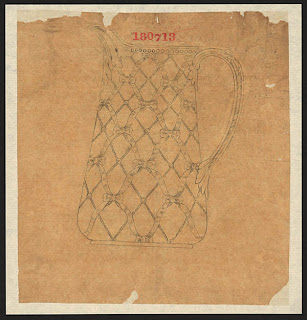
Wednesday, May 21, 2008
Titanic

who are you calling a "tea leaf" ?

National Archives
Sunday, May 18, 2008
Firing Blanks
""DUAL MARKS Because Gray's Pottery was a decorating business - buying undecorated 'white ware' from other pottery manufacturers - the pieces that the company bought usually already had a backstamp. Many Gray's pieces therefore often have two backstamps (ILLUSTRATION 3) : the original maker's mark and the Gray's mark on top of it, usually large enough and bold enough to obscure the mark beneath. Mr Gray would not necessarily want the white ware producer to take any credit for the pottery, hence his use of bold backstamps.A rare exception to the common sight of dual marks can be found in the use of one version of the Pharoah's Boat (ILLUSTRATION 4) backstamp. Produced by some sort of rubber stamp, this mark was applied to ware exclusively made for Gray's Pottery. Typically, it can be found on matt-glazed ware supplied by Kirklands of Etruria or Whieldon Ware from Winkle & Co/Ridgways of Shelton.Dual marks are often an aid in dating items. The earthenware producer Johnson Brothers of Hanley, Stoke-on-Trent, was a major supplier to Gray's Pottery and its products often have distinct date-related marks such as 'Pareek' (registered in 1925), 'Greydawn' (introduced in 1928) or 'Rosedawn' (introduced in 1930) (ILLUSTRATION 5). Lancaster & Sons, later Lancaster & Sandland, used distinctive marks such as 'English Ware' from 1944 or 'Sandland Ware' from 1949.The presence of an impressed mark can also be useful. The most common is 'JOHNSONS', usually on cup bases, but early Gray's ware often has impressed numbers. Examples are W931 (ILLUSTRATION 6), indicating a piece by Wood & Sons of Burslem, Stoke-on-Trent, and made in September 1931. Bishop & Stonier of Hanley, Stoke-on-Trent, supplied Gray's with white ware during the first 20 years of the company's existence. The characteristic entwined snake mark from Bishop & Stonier is often accompanied by one number on top of another: 2/29 meaning February 1929 ""
Saturday, May 17, 2008
Tureens - what does one do with them now?

Friday, May 16, 2008
Blue & White .... and ORANGE!


 This is a small Bisto ware vase or possible even a toothbrush holder(!) with a fantastic dragon design, dating from the late 1920s/30s- i love the puffy clouds. The bowl above has to be one of the nicest surprises i've had from buying on Ebay. It turned out to be far larger and far more beautiful than anticipated. The sprig design on the outside is the same print as that used on an aesthetic movement teaset i have already blogged about.
This is a small Bisto ware vase or possible even a toothbrush holder(!) with a fantastic dragon design, dating from the late 1920s/30s- i love the puffy clouds. The bowl above has to be one of the nicest surprises i've had from buying on Ebay. It turned out to be far larger and far more beautiful than anticipated. The sprig design on the outside is the same print as that used on an aesthetic movement teaset i have already blogged about.
delt and flow blue


About Me

- The Ticcy Knitter
- Sometimes, life doesn't turn out the way you expected. And sometimes, it is exactly as it was 'meant' to be. I believe that life is a both a learning experience and an obstacle course to be climbed and clambered over in the most creative way possible! In doing so, you'll get to where you should be even if it's not where you'd imagined.




